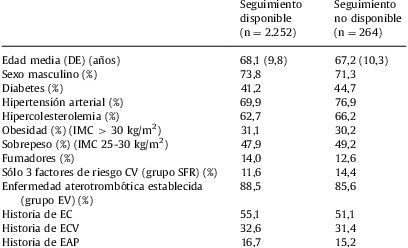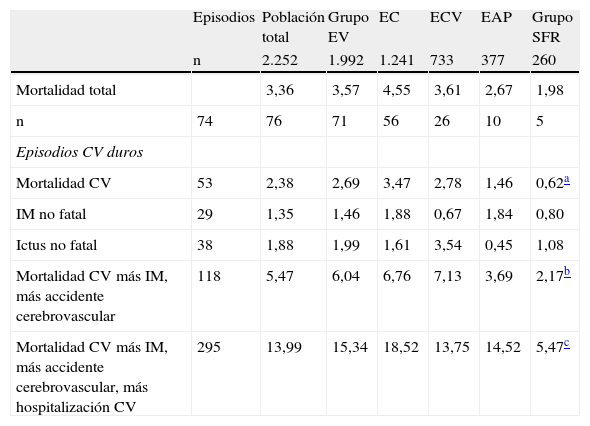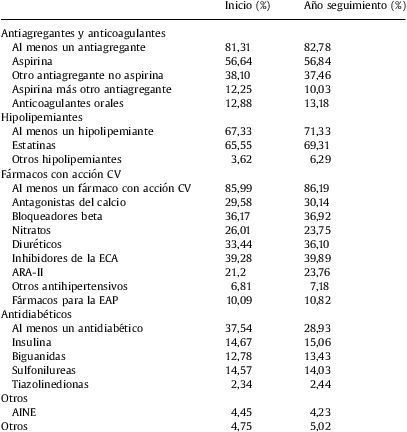REACH es el mayor registro mundial diseñado para obtener información sobre el control de factores de riesgo vascular y tratamiento preventivo en una población con aterotrombosis sintomática o de riesgo alto para desarrollarla. El objetivo del presente estudio es conocer la tasa de episodios cardiovasculares en la muestra de la población española incluida en el registro, tras un año de seguimiento e intervención.
Material y métodoEl registro REACH España es un estudio de cohorte prospectivo de sujetos con sólo factores de riesgo vascular (SFR) para aterotrombosis o con enfermedad vascular (EV) sintomática: enfermedad coronaria (EC) y/o cerebrovascular (ECV) y/o arterial periférica (EAP). Las variables principales del estudio fueron la tasa de mortalidad global, cardiovascular y la del conjunto de mortalidad cardiovascular más infarto de miocardio (IM), más accidente cerebrovascular, más hospitalización cardiovascular al año de seguimiento.
ResultadosEspaña incluyó a 2.516 sujetos, de los cuales 2.252 completaron el año de seguimiento, con una edad media de 68,1 años (73,8% de varones). El 11,6% presentaban SFR y el 88,5% EV establecida, el 55% EC, el 33% ECV y el 17% EAP. La tasa anual en los grupos EV y SFR fue, respectivamente, para la mortalidad global del 3,57 y el 1,98% (p=NS), para la mortalidad cardiovascular del 2,69% y el 0,62% (p<0,05) y para el conjunto de mortalidad cardiovascular, más IM, más accidente cerebrovascular, más hospitalización cardiovascular del 15,34 y el 5,47% (p=0,0001). La tasa anual para los subgrupos EC, ECV y EAP fue, respectivamente, para la mortalidad cardiovascular del 3,47, el 2,78 y el 1,46%, y para el conjunto de mortalidad cardiovascular más IM, más accidente cerebrovascular, más hospitalización cardiovascular del 18,52, el 13,75 y el 14,52%. La tasa anual se incrementó según tuvieran 0, 1, 2 o 3 territorios vasculares afectados, respectivamente, para la mortalidad cardiovascular (el 0,62, el 2,46, el 3,55 y el 4,32%; p<0,05) y para el conjunto de mortalidad cardiovascular, más IM, más accidente cerebrovascular, más hospitalización cardiovascular (el 5,50, el 4,18, el 20,59 y el 19,40%; p<0,0001). Al año de seguimiento, un 82,8% estaba tomando al menos un antiagregante y un 86,2% tomaba un hipolipemiante.
ConclusionesLos datos del registro REACH español al año de seguimiento en sujetos con aterotrombosis establecida o con factores de riesgo para desarrollarla muestran una alta tasa de mortalidad total y de la combinación de episodios cardiovasculares mayores, que se acentúa cuando mayor es el número de territorios vasculares afectados.
The REACH Registry is the largest worldwide designed to obtain information on cardiovascular risk factor control and preventive treatment in a population who have, or are at risk of having, symptoms of atherothrombosis. The objective of this study is to show the results of cardiovascular events obtained in a sample of the Spanish population at one year follow-up and intervention.
Material and methodThe REACH Spain registry is a prospective cohort study of subjects with vascular risk factors (ORF) for atherothrombosis or with symptomatic vascular disease (VD): coronary artery disease (CAD) and/or cerebrovascular disease (CVD) and/or peripheral artery disease (PAD). The main outcome measures were rates of all-cause mortality, cardiovascular (CV) death, and the overall combined CV death, myocardial infarction (MI), or stroke and CV hospitalization at one year follow-up.
ResultsIn Spain 2,516 patients were recruited and 2,252 completed one year follow-up, the mean age was 68,1 (73,8% men), 11,6% of subjects with ORF and 88,5% with VD, 55% with CAD, 33% with CVD and 17% with PAD. The annual rate of all-cause mortality in VD and ORF groups were 3,57% and 1,98% (NS) respectively, while for CV death they were 2,69% and 0,62% (P<.05) and for overall combined CV death myocardial infarction (MI), or stroke and CV hospitalization they were 15,34% and 5,47% (P=.0001). The annual rate of CV death for CAD, CVD and PAD groups were 3,47%, 2,78% and 1,46% respectively, and for the overall combined CV death, myocardial infarction (MI) , or stroke and CV hospitalization they were 18,52%, 13,75% and 14,52%. These event rates increased with the number of symptomatic arterial disease locations from 0,1,2 or 3 for CV death (0,62%, 2,46%, 3,55% and 4,32%, respectively P<.05) and for overall combined CV death myocardial infarction (MI), or stroke and CV hospitalization (5,50%, 4,18%, 20,59% y 19,40%, respectively P<.0001). At one year follow-up, 82,8% of the patients were with at least one antiplatelet drug and 86,2% were receiving lipid-lowering agents.
ConclusionsThe REACH Spain Registry at one year follow-up in patients with atherothrombotic disease or at risk of having symptoms of atherothrombosis shows a high rate of all-cause mortality and of overall combined major CV events, which is becoming higher as the number of symptomatic arterial disease locations increases.
Artículo
Comprando el artículo el PDF del mismo podrá ser descargado
Precio 19,34 €
Comprar ahora













